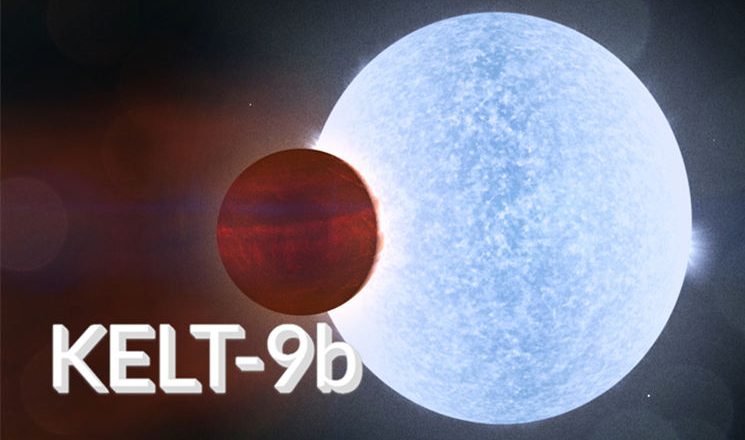In the vast expanse of our cosmos, KELT-9b emerges as a captivating celestial entity, a scorching hot Jupiter in orbit around the luminous star KELT-9, situated approximately 670 light-years away from Earth. Unveiled through the lenses of the Kilodegree Extremely Little Telescope, the revelation of KELT-9b unfolded in 2016 and continues to hold the distinction of being the hottest known exoplanet as of October 2022. Its stellar host, KELT-9, a B-type/early A-type star, surpasses the sun in size by 2 to 3 times and in mass by 2 to 5 times, boasting an extraordinary surface temperature of 10,170K. Prior to the detection of KELT-9b, the presence of planets was recognized only around six A-type stars, with none identified around B-type stars. Classified as B9.5-A0, KELT-9 challenges convention as it may well be the first B-type star known to harbor a planet. Orbiting at a mere 0.03462 AU from KELT-9 with an orbital period of less than 1.5 days, KELT-9b’s circular yet strongly inclined orbit classifies it as an “ultra-hot Jupiter.”
This exoplanet, with its massive size, peculiar density, and extreme temperatures, provides scientists with an unprecedented laboratory to explore atmospheric dynamics, orbital kinetics, and the intricate interplay between a star and its orbiting planet. From its colossal mass to the astounding temperatures and eccentric orbital characteristics, KELT-9b beckons researchers to delve into the realms of planetary atmospheres, orbital dynamics, and stellar-planet interactions under the most extreme conditions. This article embarks on an in-depth examination of KELT-9b’s physical properties, atmospheric dynamics, and its intricate dance with the formidable KELT-9, aiming to unravel the enigmatic features of this extraordinary celestial body and illuminate how these revelations advance our understanding of exoplanets and the extremes that define our cosmic landscape.
The Orbit and Fundamental Characteristics of KELT-9b:
KELT-9b has garnered significant attention due to its close proximity to its host star and exceptionally short orbital period. Situated approximately 670 light-years away from Earth, KELT-9b orbits the B-type/early A-type star KELT-9 along a circular yet extremely inclined trajectory. Its orbital distance from KELT-9 is a mere 0.03462 astronomical units (AU), and the orbital period is less than 1.5 days. This designates KELT-9b as an “extreme close-in planet,” capturing the scientific community’s widespread interest in the extreme nature of its orbital characteristics.
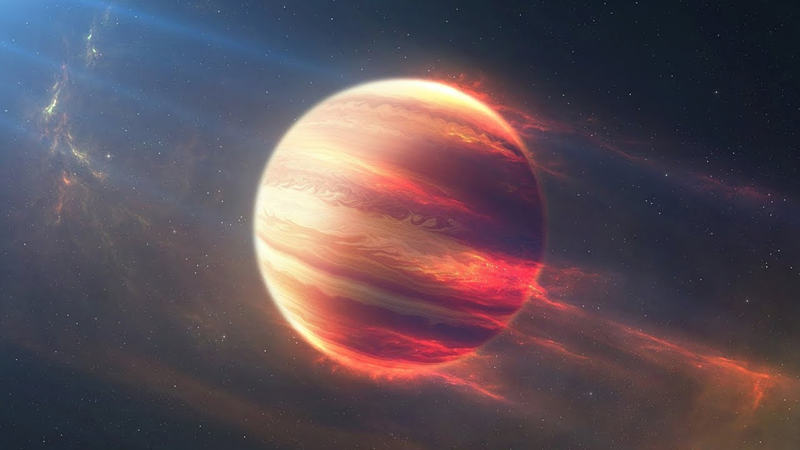
The designation of “extreme close-in planet” for KELT-9b stems from its extremely close proximity to the host star. The planet completes one orbit around the star every 1.5 days, resulting in a strongly circular and highly inclined orbit. This orbital configuration causes KELT-9b to experience two summers and two winters within each orbital cycle, with each season lasting only around nine hours. The unique seasonal sequence arises from the combination of the orbit’s inclination and its remarkably short orbital period.
KELT-9b’s orbital features not only make it a valuable specimen for planetary studies but also provide scientists with an opportunity to delve into the dynamics of extreme celestial bodies and planetary climatology. A thorough understanding of the orbit of this “extreme close-in planet” is poised to contribute to unraveling the formation and evolution processes of planets under extreme conditions in the universe.
Temperature and Atmosphere of KELT-9b:
The extreme temperature of KELT-9b, coupled with its unique atmospheric conditions, has been a focal point of scientific inquiry. With a dayside temperature surpassing 4,600 K, KELT-9b holds the distinction of being the hottest known exoplanet as of 2022, even exceeding the temperatures of some K-type stars. This intense heat has profound implications for the composition and dynamics of its atmosphere.
The hostile conditions on the dayside of tidally-locked KELT-9b are so extreme that molecules, including hydrogen gas, are torn apart and unable to remain intact. The dayside temperature, exceeding 7,800 degrees Fahrenheit (4,600 Kelvin), surpasses that of most stars. The host star, KELT-9, is a blue A-type star, even hotter than the already scorching exoplanet. This extreme radiation from the host star has caused the planet’s atmosphere to expand significantly, resembling a ballooning effect.
The planetary atmosphere of KELT-9b exhibits intriguing features. Molecules on the dayside are broken into their component atoms due to the intense radiation, allowing normally sequestered refractory elements to exist as atomic species. These elements include neutral oxygen, neutral and singly ionized atomic iron (Fe and Fe+), and singly ionized titanium (Ti+). While these atomic species temporarily reform as they reach the cooler night side, the atmospheric dynamics involve a continuous cycle of dissociation and recombination of molecular hydrogen.
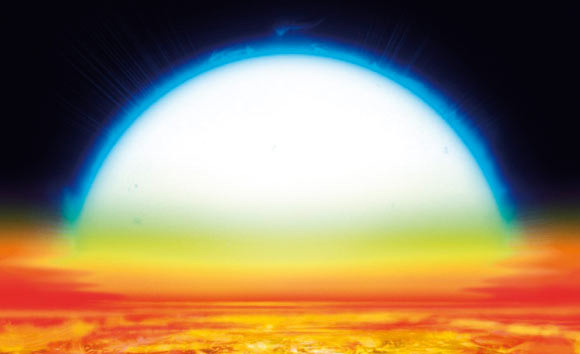
Spectra taken in 2021 have indicated the presence of metal oxides and hydrides in the planetary atmosphere, further highlighting the extreme conditions on KELT-9b. The nightside of the planet, although still extremely hot, provides a temporary respite for the disconnected atoms to re-form molecules before being torn apart once again upon returning to the dayside.
The thermosphere layer of KELT-9b is expected to heat up to 10,000–11,000 K, primarily driven by the ionization of heavy metals such as iron. This ionization process contributes to the intricate dynamics of the planet’s atmosphere under the relentless influence of its host star’s radiation.
In summary, KELT-9b’s astronomical temperatures and atmospheric peculiarities make it a captivating object of study, shedding light on the extreme conditions that govern exoplanetary atmospheres and providing valuable insights into the broader understanding of celestial bodies in our universe.
Astronomical Observation Tools and Methods:
The exploration of KELT-9b relies on a variety of astronomical observation tools, including ground-based telescopes and space telescopes, to unveil the mysteries surrounding this ultra-hot Jupiter exoplanet.
The Kilodegree Extremely Little Telescope (KELT) played a pivotal role in the discovery of KELT-9b in 2016. This ground-based telescope, strategically positioned across locations in southern Arizona and South Africa, contributed to the initial detection of the exoplanet. Its collaborative observational system enabled scientists to collect essential data and initiate the detailed study of KELT-9b’s physical properties.
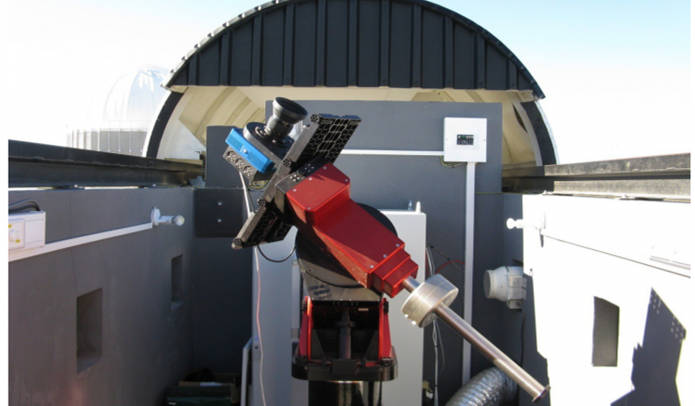
Additionally, space telescopes, such as NASA’s Spitzer Space Telescope, have been instrumental in advancing our understanding of KELT-9b’s atmosphere. The Spitzer Space Telescope, operating in the infrared spectrum, provides a unique vantage point for observing subtle variations in heat. By analyzing temperature data from both the day- and nightsides of KELT-9b as it orbits its host star, astronomers can discern critical information about the planet’s atmospheric dynamics.
The extreme conditions of KELT-9b, characterized by its scorching temperatures and unique atmospheric phenomena, necessitate specialized observational techniques. The Spitzer Space Telescope, with its ability to capture infrared emissions, allows scientists to investigate the temperature differentials and atmospheric composition of the exoplanet. The evidence gathered through these observations supports the conclusion that hydrogen molecules on the dayside of KELT-9b are torn apart due to the planet’s extreme heat.
The observational tools and methods employed in studying KELT-9b provide scientists with valuable insights into the exoplanet’s composition, atmospheric escape, and the intriguing interactions between its dayside and nightside. The combination of ground-based and space-based observations enhances our ability to unravel the complexities of this ultra-hot Jupiter and contributes to the broader understanding of exoplanetary systems in our vast universe.
KELT-9b’s Evolution and Dynamics:
The evolution and dynamics of KELT-9b are shaped by various external forces, including tidal forces, radiation, and other influences. These factors contribute to the modulation of the planet’s magnetic field, atmospheric evolution, and the overall long-term development of the exoplanet.
Tidal forces play a significant role in the behavior of KELT-9b, given its tidally locked orbit with the host star, KELT-9. The gravitational interactions between the planet and its star induce tidal effects, resulting in a synchronized rotation where one side of the planet permanently faces the star. This tidal locking influences the distribution of gases and heat on KELT-9b, creating extreme temperature differentials between the dayside and nightside.
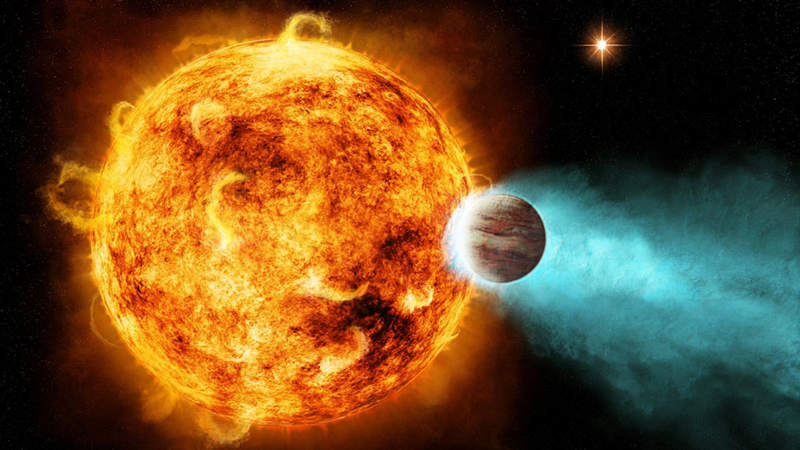
The intense radiation from the host star also plays a crucial role in the exoplanet’s dynamics. The extreme surface temperature of KELT-9, reaching 10,170 K, subjects KELT-9b to an intense radiation flux, driving atmospheric escape. The planet’s atmosphere, extending close to its Roche lobe, experiences rapid loss, as indicated by the measured atmospheric escape rate of 18 – 68 Earth masses per billion years in 2020. This phenomenon contributes to the unique characteristics of KELT-9b, such as its inflated atmosphere and the intriguing presence of refractory elements in atomic species.
The dynamics of KELT-9b’s atmosphere are further influenced by ionization processes, particularly the ionization of heavy metal atoms like iron. The thermosphere layer is expected to heat up to 10,000–11,000 K due to these ionization effects. The extreme conditions on the dayside, where hydrogen molecules are torn apart, present a complex interplay between radiative and dynamical processes, leading to the temporary existence of metal oxides and hydrides in the planetary atmosphere.
Additionally, KELT-9b’s peculiar orbit, perpendicular to the spin axis of its host star, contributes to its unique seasonal sequence. With each orbit lasting less than two Earth days, the planet experiences two summers and two winters every orbit, each season lasting about nine hours. The youthfulness of the KELT-9 star, being only 300 million years old, further adds to the complexity of KELT-9b’s environment.
In summary, the evolution and dynamics of KELT-9b are intricately linked to tidal forces, radiation, and other external influences. These factors sculpt the planet’s magnetic field, drive atmospheric escape, and contribute to the remarkable phenomena observed in this hottest known exoplanet. Ongoing observations, such as those conducted by the Spitzer Space Telescope, continue to enhance our understanding of the complex interplay of forces shaping KELT-9b’s celestial environment.
Comparison with Other Hot Gas Giants:
The distinctive characteristics of KELT-9b make it an ideal subject for in-depth comparisons with other hot gas giants, including well-known ones like WASP-121b. By analyzing the similarities and differences among them, scientists can gain a more comprehensive understanding of the common features and unique traits of this class of planets.
Firstly, in comparison to other hot gas giants, KELT-9b was confirmed in 2022 as the hottest known exoplanet. With a dayside temperature approaching 4,600 K, it surpasses some K-type stars. This feature renders KELT-9b a captivating subject for research due to its extreme temperature, even hotter than some stars.

The comparison of KELT-9b with other planets also involves its physical properties. As a relatively massive giant planet, it has a mass approximately 2.8 times that of Jupiter. However, due to its radius being nearly twice that of Jupiter, its density is less than half that of Jupiter. This low density may result from atmospheric expansion in its extreme thermal environment. Like other hot gas giants, KELT-9b is tidally locked to its parent star, with one side perpetually facing the star. However, the relatively inclined orbit of KELT-9b adds a unique dynamic to its orbital characteristics.
Furthermore, the atmospheric composition of KELT-9b has drawn attention in the comparison. Although its elemental abundances were not known as of 2022, scientists suspect a low carbon-to-oxygen ratio. This forms a contrast with the potential different elemental compositions present in other hot gas giants.
Lastly, the orbital orientation of KELT-9b adds a distinctive feature to its comparison. Unlike other hot gas giants, its orbit is perpendicular to the rotation axis of its parent star, similar to the orientation of Earth’s orbit being perpendicular to the plane of our solar system. This results in its unique seasonal sequence, featuring two summers and two winters in each orbit.
Overall, by comparing KELT-9b with other hot gas giants, scientists can delve into the commonalities and differences among these planets, potentially offering more insights into unraveling the mysteries of this planetary category.
END:
In summary, the study of KELT-9b has revealed significant insights into planetary evolution and extreme atmospheric conditions, underscoring the importance of observing and analyzing this unique exoplanet. The findings indicate that KELT-9b stands out as the hottest known exoplanet as of 2022, with a dayside temperature surpassing 4,600 K, exceeding even some K-type stars. The observations of the planet’s atmospheric composition reveal the disintegration of molecules, particularly hydrogen, on the dayside due to the intense heat.
The physical properties of KELT-9b, including its relatively large size with a mass 2.8 times that of Jupiter but lower density, present intriguing characteristics. Its tidally locked state and strongly inclined orbit contribute to the distinct dynamics of its interaction with the host star. Additionally, the perpendicular orbital orientation sets KELT-9b apart from other hot gas giants, leading to a peculiar seasonal sequence with two summers and two winters experienced during each orbit.
The extreme conditions on KELT-9b, where molecules are torn apart due to the intense heat, have broader implications for our understanding of exoplanets with similar characteristics. The study suggests that the phenomenon of molecular disintegration might extend to other ultrahot exoplanets, emphasizing the significance of this unique planetary category. The evidence gathered through observations, particularly with the Spitzer Space Telescope, contributes to unraveling the mysteries of these extreme exoplanetary environments.
Looking ahead, potential future research directions and observational needs could include further investigation into the elemental abundances of KELT-9b, detailed analysis of its atmospheric dynamics, and exploring similar phenomena on other ultrahot exoplanets. The unique features of KELT-9b position it as a crucial object of study, offering valuable insights into the diverse nature of exoplanets and advancing our understanding of extreme planetary conditions.
More UFOs and mysterious files, please check out our YouTube channel: MysFiles
Mysterious Stone Spheres around the world – Costa Rica, European forest, Russia, Kazakhstan
